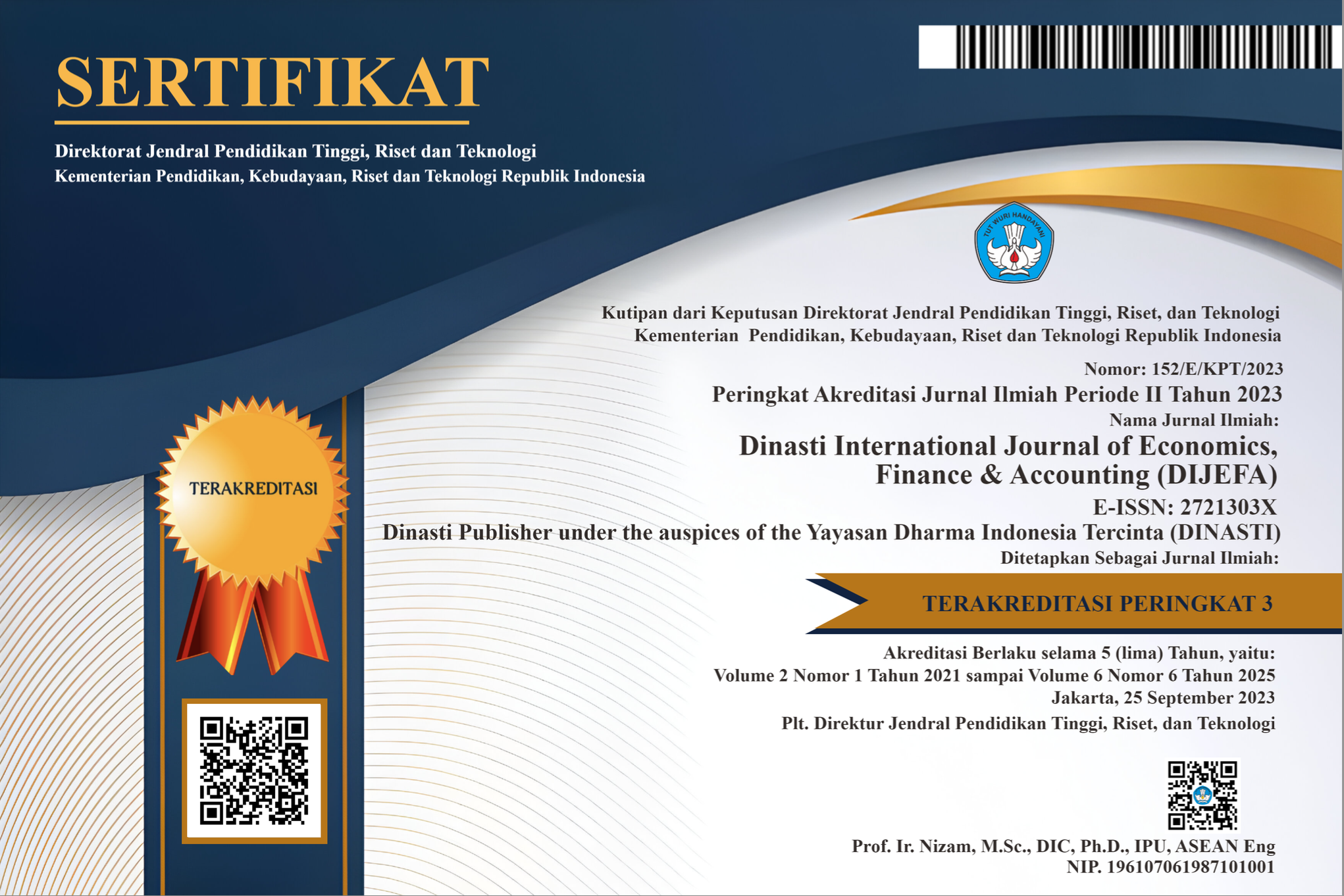Implementation of Verified Containers Carried on Ships (Gross Mass and Container Verification) – VGM at Belawan Container Terminal
DOI:
https://doi.org/10.38035/dijefa.v5i4.3388Keywords:
Shipping Safety, Containers, Verified Gross MassAbstract
Abstract: Implementation of Verified Containers Carried on Ships (Verified Gross Mass of Container) – VGM at Belawan Container Terminal (Research Team Supriadi and Christy Pongkessu). In an effort to improve shipping safety and minimize the risk of damage or accidents at sea due to load imbalance and overloading on ships, in May 2014 the International Maritime Organization - The Maritime Safety Committee (IMOMSC) has decided to approve changes to The International Convention for the Safety of Life at Sea (SOLAS) 1974 Chapter VI Article 2 concerning the requirements for verifying the gross weight of containers (Verified Gross Mass of Container/ VGM). Verified Gross Mass (VGM) is validated container weight information using scales that have been certified and accounted for by a verifier. This study aims to determine the implementation and impact of the implementation of Verified Gross Mass (VGM) at Belawan Port. This research was conducted at Belawan Port located in Medan City, North Sumatra, Indonesia for 6 (six) months, namely from May to October 2023. The type of research used is qualitative research. Qualitative research methods are research methods based on the philosophy of postpositivism, data collection techniques with triangulation (combined), inductive/qualitative data analysis. Based on the results of the study, it was concluded that Belawan Port has implemented the Verified Gross Mass (VGM) procedure in accordance with SOLAS (Safety of Life at Sea) regulations. This process involves verifying the gross weight of containers before loading onto ships using appropriate weighing equipment. The main impact of implementing Verified Gross Mass (VGM) is increasing the safety of container ship navigation. By ensuring the correct gross weight of containers, ports can prevent ship accidents caused by gross weight inaccuracies.
Keywords: Shipping Safety, Containers, Verified Gross Mass
References
Anggi S. Wangi. (2016). Berat Kotor Terverifikasi (VGM),
Aras, E and Chen, PS-L. (2019). The effect of the Verified Gross Mass (VGM) implementation in Australia, Proceedings of 4th Belt and Road Initiative Conference 2019, 1-3 August 2019, Bangkok, Thailand, pp. 1-20.
Fedi, L., Lavissiere, A., Russell, D., & Swanson, D. (2019). The facilitating role of IT systems for legal compliance: the case of port community systems and container Verified Gross Mass (VGM). Supply Chain Forum, 20(1). https://doi.org/10.1080/16258312.2019.1574431
International Convention for the Safety of Life at Sea SOLAS. 1974
Jagel?ák, J., Kiktová, M., & Stopková, M. (2018). The application of the verified gross mass of intermodal loading units in the conditions of the Slovak Republic. Nase More, 65(4 Special issue). https://doi.org/10.17818/NM/2018/4SI.10
Ketentuan International Maritime Organization (IMO) amandemen aturan Safety of Life at Sea (SOLAS) (Chaper VI/2 – Verification Gross Mass) (2016).
King, M. (2016). The problem of misdeclared container weight: perspectives from New Zealand and implications for its law. WMU Journal of Maritime Affairs, 15(2). https://doi.org/10.1007/s13437-015-0091-3
Lasse, S.H., M.M. (2016). Manajemen Kepelabuhanan. Jakarta: PT. Raja Grafindo Persada.
Pakpahan, K. et al., 2020. Verified Gross Mass Provisions and Port Accident Prevention. Palarch’s Journal of Archaeology of Egypt/Egyptology, 17(4), 1592-1608(1567-214x).
Peraturan Dirjen Perhubungan Laut Nomor HK.103/2/4/DJPL-16 Tentang Berat Kotor Peti kemas Terverifikasi Yang Diangkut Di Kapal.
Peraturan Menteri Perhubungan Republik Indonesia Nomor PM 25 Tahun 2022, Berat Kotor Peti Kemas Terverifikasi (Verified Gross Mass/ VGM)
PP RI Nomor 61 Tahun 2009 Tentang Kepelabuhanan.
R.P Suyono. (2007). shipping edisi keempat, PPM dan PT. Anggoya Ikapi, Jakarta, 2007.
Rahmatika, R., Putri, R. A., P. Sirait, D., & Setyawati, A. (2018). The Impact Of VGM (Verified Gross Mass) Implementation As Solas’s New Regulation - Case Study At Port Of Tanjung Priok. https://doi.org/10.2991/grost-17.2018.60
Ridwan. (2019). Implementasi VGM (Verified Gross Mass) Di Pelabuhan Tanjung Emas Semarang. Majalah Ilmiah Gema Maritim, 21(1), 40-47. https://doi.org/10.37612/gema-maritim.v21i1.5
Sugiyono. (2015). Metode Penelitian Kuantitatif, Kualitatif, Dan R&D Cetakan 12. Bandung, Alfabeta.
Tai, S. K. (2016). The application of the verified gross mass rules in Hong Kong. Maritime Business Review, 1(3). https://doi.org/10.1108/MABR-09-2016-0023
Thabah, Asep Ali; Saputra, Abdul Hafidh dan Hanifah. (2018). Keselamatan Pelayaran Kapal Pada PT Jakarta International Container Terminal Tanjung Priok. Jurnal Manajemen Bisnis Transportasi Dan Logistik, 4(2), 249 – 260.
UU Nomor 17 Tahun 2008 Tentang Pelayaran.
Undang-undang Republik Indonesia Nomor 17 Tahun 2008 Tentang Pelayaran. Jakarta: Sinar Grafika
Downloads
Published
How to Cite
Issue
Section
License
Copyright (c) 2024 Jumriani, Subehana Rachman, Annisa Rahma, Asnur

This work is licensed under a Creative Commons Attribution 4.0 International License.
Authors who publish their manuscripts in this journal agree to the following conditions:
- The copyright on each article belongs to the author(s).
- The author acknowledges that the Dinasti International Journal of Economics, Finance & Accounting (DIJEFA) has the right to be the first to publish with a Creative Commons Attribution 4.0 International license (Attribution 4.0 International (CC BY 4.0).
- Authors can submit articles separately, arrange for the non-exclusive distribution of manuscripts that have been published in this journal into other versions (e.g., sent to the author's institutional repository, publication into books, etc.), by acknowledging that the manuscript has been published for the first time in the Dinasti International Journal of Economics, Finance & Accounting (DIJEFA).


























































